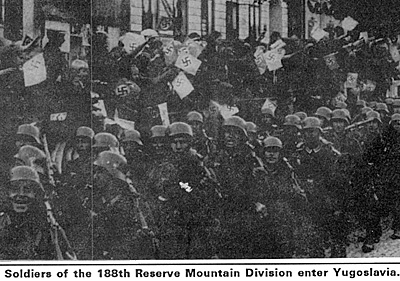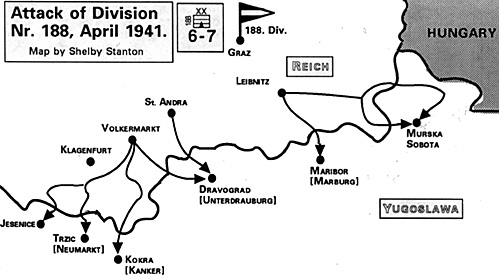 One enjoyable aspect of Europa
research is the great wealth of
detail that the system allows.
Unique military formations always
add distinctive flavor to the gaming
experience, and the 188th Reserve
Mountain Division is one of those
special entities that gives flair to
the Balkans campaign covered in
Balkan Front.
One enjoyable aspect of Europa
research is the great wealth of
detail that the system allows.
Unique military formations always
add distinctive flavor to the gaming
experience, and the 188th Reserve
Mountain Division is one of those
special entities that gives flair to
the Balkans campaign covered in
Balkan Front.
The division was formally known simply as Division Nr. 188. During November and December 1939 it was raised in Salzburg from elements of the Military District XVIII Reserve Command for Replacement Troops (Kdr. der Ersatztruppen XVIII). The reservist division was composed of the 36th, 138th, and 139th Mountain Replacement Regiments from Innsbruck, Graz, and Klagenfurt respectively. The formation was given an active role guarding the rugged Reich frontier between former Austria and Yugoslavia, a task that gave plenty of hiking and climbing experience to its members.
The decision to represent the formation as a reserve mountain division was the result of careful analysis of its character and fighting ability. The high-quality replacement mountaineering composition of the regiments, especially at this stage of the war, demanded appropriate representation. Another factor was the reservist origin and the fact that the majority were still reservists being programmed as replacements for the Reich's regular mountain units. The result was a reserve mountain division symbolization with good combat and mobility value.
The 188th Division headquarters was located at Graz, the traditional governmental seat of Austrian Styria (Steiermark). The assignment was considered a choice posting because Graz was easily one of the most pleasant and healthiest of Austrian provincial capitals. The division served as a reserve formation, and its stationing coincided with numerous retirement opportunities for officers and enlisted men residing in the community and surrounding areas.
The city of Graz was situated on both banks of the Mur River, then crossed by seven bridges. The central buttresses of the Franz Karl Bridge were adorned with handsome bronze figures of both Austria and Styria by the sculptor Brandstetter. This was an apt representation because the Austrian citizens of Graz were staunch, hardy Styrians. They were eager to free their brethren from the "yoke of Yugoslavian control," and Nazi propagandists heightened this crusading zeal.
 The 188th kept its mountain reserve troops busy patrolling and
monitoring the Third Reich's mountainous border with
Yugoslavia. The division's soldiers of 1940-41 demonstrated superior
athletic and skiing skill, and were extremely nationalistic. They
viewed Yugoslavia distastefully as a dubious post-world war
imposition that imprisoned fellow Styrians, as well as Carnolians and
Carinthians, in an alien and inferior nation. Almost to a man, the
division's troops viewed any forthcoming conflict as a welcome
opportunity to "liberate" "fellow Germans."
The 188th kept its mountain reserve troops busy patrolling and
monitoring the Third Reich's mountainous border with
Yugoslavia. The division's soldiers of 1940-41 demonstrated superior
athletic and skiing skill, and were extremely nationalistic. They
viewed Yugoslavia distastefully as a dubious post-world war
imposition that imprisoned fellow Styrians, as well as Carnolians and
Carinthians, in an alien and inferior nation. Almost to a man, the
division's troops viewed any forthcoming conflict as a welcome
opportunity to "liberate" "fellow Germans."
Into Yugoslavia
During early 1941, the division was already in place along the Reich border and alerted for the Balkan offensive. Once operations commenced, the division was given the mission of consolidating German control over the adjacent Yugoslavian areas of former Carnolia and Carinthia as quickly as possible. Each of the three mountain replacement regiments were assigned separate avenues of advance for the pending Balkans onslaught.
The 138th Mountain Replacement Regiment was poised at Leibnitz, an ancient Roman trading site near the Austrian border due south of the division command post at Graz. The regiment was assigned to mop up the division's eastern flank by occupying the largest chunk of Styrian border territory in two separate drives.
The first drive involved the regiment's mobile battalion. The unit was assigned to overpower the extreme northeastern portion of Yugoslavia, sandwiched between the Reich and Hungary. The area was distinct from the rest of the frontier because it was inhabited by Magyarian Slovenes and Hungarians, considered hostile to German intrusion. The battalion's two mobile wings raced across the border in a wide pincer-style arc that closed shut at Murska Sobota on April 6. Resistance against the flying columns was negligible because Yugoslavian forces abandoned this exposed shoulder of their country and chose not to fight.
 The other regimental
objective was Maribor, a pro-Reich
area already well-infiltrated by the Nazi
movement. The picturesque town was
situated at the foot of the Posruck
heights on the left bank of the Drave
River, and best known as the center of Styrian fruit
and wine cultivation. Despite the town's
mostly German population, the target
was reserved for an entire battalion in
case something went wrong. The
dangerous approach march involved
difficult movement along an alpine road
that crossed over the spine of the
Windish hills. The soldiers would have
to march through two tunnels and
across one long, antiquated Roman
viaduct before reaching Maribor'
The other regimental
objective was Maribor, a pro-Reich
area already well-infiltrated by the Nazi
movement. The picturesque town was
situated at the foot of the Posruck
heights on the left bank of the Drave
River, and best known as the center of Styrian fruit
and wine cultivation. Despite the town's
mostly German population, the target
was reserved for an entire battalion in
case something went wrong. The
dangerous approach march involved
difficult movement along an alpine road
that crossed over the spine of the
Windish hills. The soldiers would have
to march through two tunnels and
across one long, antiquated Roman
viaduct before reaching Maribor'
The 138th's lead battalion started its march by filing past the chateau of Baroness Salvi, located on a wooded height to the right. The officers told their soldiers that the deceased princes of Eggenberg were watching their progress from tombs in the chateau's adjoining dome-covered chapel. This final speech was supposed to hearten morale, but many reservists felt that the attack was commencing on a rather somber note.
The battalion marched swiftly forward past Baron Bruck's chateau at Spielfeld and then began the uphill trek over the Windish range separating the Mur and Drave rivers. This was the most dangerous part of the journey because it involved going through the Egidi Tunnel and crossing a deep valley utilizing the seven hundred-yard long, precarious imperial viaduct of sixty-four arches.
Luck was with the battalion, however, as several Nazi townspeople made sure the route was safe. The troops then descended Posruck Mountain through the Leitersberg Tunnel and entered Maribor on April 5, escorted by pretty Fascist-Youth girls who showered the lead troops with flowers. The town's capture marked the first fall of an enemy objective to division troops. The battalion was also a day ahead of their more mobile compatriots to the northeast.
The 138th's triumphant entry into Maribor was attended with all the fanfare imaginable. The town's statue of Admiral Tegetthoff (hero of Lissa and apparently the only native of historical consequence) was festooned with floral wreaths; the soldiers lined up in the state park near the monument to Emperor Joseph II; and the commandant promptly renamed the city as Marburg. Some machine gun crews were posted across the long bridge over the Drave.
Their positions commanded the broad valley on the river's southern side, but no counterattacks developed. The Styrian residents were decidedly pro-German, and Yugoslavian units would not contest the area.
Central Thrust
The central divisional thrust into the Carinthian middle sector of Yugoslavia was conducted primarily by the 136th Mountain Replacement Regiment. This unit, initially posted to St. Andra, was charged with securing the road southward to the frontier blocking position of Dravograd. The German title for the town was Unterdrauburg ("Under Drauburg"), a logical name because it was located underneath the ruins of Drauburg Castle, a former fortress dominating the high peak that overlooked the influx of the Missbach into the Drave river.
The village was a key road junction and its capture was entrusted to a two-pronged German assault. While the 136th moved straight south towards the crossroads, a sister battalion of the 139th Mountain Replacement Regiment crossed the Austrian border further west and hit Dravograd from the flank. The combined thrust was calculated to carry the potential strongpoint regardless of enemy defensive intentions. The prompt clearance of Dravograd would assure a pathway into a very important Yugoslavian target on Hitler's menu, the Sarin river town of Celj (Cilli), first founded by Roman Emperor Claudius.
The 136th Mountain Replacement Regiment filed out of the quaint town of St. Andra, once the residence of the princely bishops of the Lavant Valley, and passed south toward gradually rising Alpine heights. The march south was marked by the passing of St. Paul and its extensive Benedictine abbey. More castle ruins dotted the forested slopes as the fertile valley narrowed. The Austrian border paralleled the Drave River for a distance and this advantage enabled the battalion to stay within German territory before crossing hastily within striking range of Dravograd.
The flanking battalion from the 139th had a much longer trek because it traveled from Austrian Volkermarkt in an easterly direction across numerous ridges. Nevertheless, the envelopment was swiftly accomplished and Unterdrauburg fell as expected.
The 139th Mountain Replacement Regiment parceled out the rest of its companies in a series of southward commando-style ventures along traditional invasion routes into South Carinthia. One forward company dashed past gorges and cascading waterfalls to seize the saddle of Seeberg Mountain astride the frontier.
The rocky summits were taken as selected German troops advanced to the top of the Grintouz, the highest of the Steiner Alps. Other companies skirted the precipices and swept into Kokra on April 10. The fall of Kokra, retitled by the Germans as Kanker, opened the road leading further south into the heart of Carnolia.
Other components of the 139th took alternate mountain paths south. One element headed south from Austrian Klagenfurt, marched through the Laibl Pass on the international boundary, and reached the Slovenian town of Trzic on April 7. The arriving German troops knocked down the signposts and erected new billboards labeling the town as Neumarkt. The German infantry continued their march past both Neumarkt and Kanker, and converged to capture the strategic city of Kranj. The city was declared a Germanic settlement area and renamed Krainburg for the duration of the war.
The final 139th regimental effort involved a detached company that attacked southward from Villach to secure the division's far western flank. The troops moved out of the marshy meadows and sped toward the Karawanken mountain range that separated the valleys of the Drave and Save rivers. The troops traversed the five-mile tunnel and took Jesenice at the other end during 8 April. Later Radovljica, renamed Radmannsdorf, was seized and German possession of the Carinthian corner pocket adjoining Italy was assured.
The swift and successful campaign of the 188th Division can be attributed to the agility of its Austrian replacement mountaineers, who demonstrated a passionate zeal for rescuing their "countrymen" from Yugoslavian "oppression." During October 1943 the 188th was redesignated officially as a Reserve Mountain Division. Finally, in March 1945, the formation was upgraded to full mountain division status as the 188. Gebirgs Division. Naturally, this future evolution of the formation will be unfolded for Europa enthusiasts as part of the upcoming Second Front.
Back to Europa Number 15 Table of Contents
Back to Europa List of Issues
Back to MagWeb Master Magazine List
© Copyright 1990 by GR/D
This article appears in MagWeb (Magazine Web) on the Internet World Wide Web. Other military history articles and gaming articles are available at http://www.magweb.com